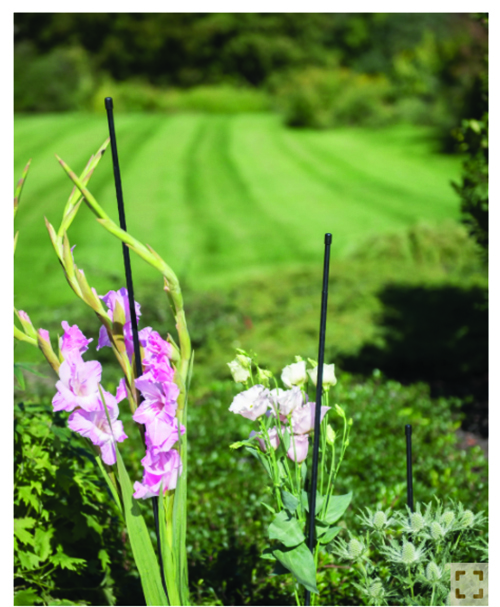When your garden plants have flopped or threatened to keel over, you may have tried staking or cages. Sometimes that works…sometimes it doesn’t. Let’s take a closer look—and make your gardening life easier this year with some “best practices” secrets and alternative products to consider.
Steel Stakes
If your bamboo or wood stakes tend to lean or fall over before a plant has reached its full size, it’s time to graduate to a steel tube, galvanized-steel pole or even rebar.
“Corkscrew” metal poles look like a gimmick, but I was favorably impressed. They are quite secure once in place and accommodate wayward growth and interval tying with more flexibility than plain verticals. They are especially well-suited for big, burly tomato varieties.
The Ties That Bind
Upright-growing plants, such as tomatoes, pole beans, sweet peas and more, must be fastened to a support at intervals—a weekly chore throughout the summer months. How wide to make those intervals depends on the plant (how top-heavy it’s becoming, where side growth emerges), but every eight to 12 inches as a plant ascends is a good rule of thumb.
What you tie with matters! Twist or zip ties, string or wire can abrade or even cut into a stem. Instead, use yarn, old pantyhose or strips of old t-shirts. Tie a square knot around the stake so it won’t slip, then a loose square knot around the stem. This not only prevents abrasion but gives a stem a little latitude on windy days.

Alternatives to Tapered Circular Cages
Traditional tomato cages are deservedly popular because they are simple and practical, but they are not always up to the job. If your tomatoes (or okra, beans or peppers) outgrow them, obviously, start using larger ones. When you go shopping, you will see that they come in taller and wider sizes—overestimating is rarely regretted! Or look to the alternatives—supports made of metal tend to be longer-lasting and sturdier than wooden ones, so study your options.
Square cages: These have a bigger “footprint” for better stability. They come in various sizes and heights, including especially tall ones called “towers.”

Ladder supports: Look for the A-frame ones, which offer an extra plane of support. Tying still may be necessary.

Trellises: A strong upright one may be sufficient for bean or cucumber plants, but heavier crops such as melons are better off when a trellis is set up at an angle against a fence or wall to support it.

Rings Around the Flowers
Some favorite garden flowers—peonies, sedums, Siberian irises, Russian sage, Shasta daisies—tend to become open in the center and flop outward.
Store-bought solutions are simple to install and look better than homemade rigs of sticks and twine. Thin plastic-coated metal stakes in green or black become hidden from view as a plant fills in. Options include…
Linking stakes: Each one has a loop at the top and a hook at the end of its horizontal arm for joining it to the loop of an adjacent one. Form rings or lines as long or wide as needed.

Scalloped-edge supports: Use along the viewer-facing side of an unruly plant, or deploy several to completely surround it. The undulating curves are attractive, an advantage when the plant’s growth doesn’t completely hide the support, such as with a burly sedum.

Grow-throughs: These come in various diameters. Vertical support is topped with mesh or a grid (they look like little tables). Especially important to install early, so a plant can grow up through the openings and thereby be well-supported. Particularly perfect for peonies.

Support-loop stakes: If you need to hold up a single weak or top-heavy stem, such as a tulip or a lily, use one of these. I buy in quantity—in heights from one to five feet—and use as needed.

Buying tips
Home and garden centers offer a range of plant supports. But for a much wider selection of materials, sizes and designs, I prefer specialty mail-order sources such as Gardeners.com and KinsmanGarden.com. Prices range from $20 to more than $100, depending on size and material.
Installation tips
Put supports in place at the time of planting, so they’ll be there when growth takes off and also because you don’t want to risk poking into and possibly harming an established root system.
For stability, the deeper you can plunge a support into the ground, the better—a foot or more is not excessive for heavy plants. If you need to make a “pilot hole” for a thick stake, use a crowbar.


